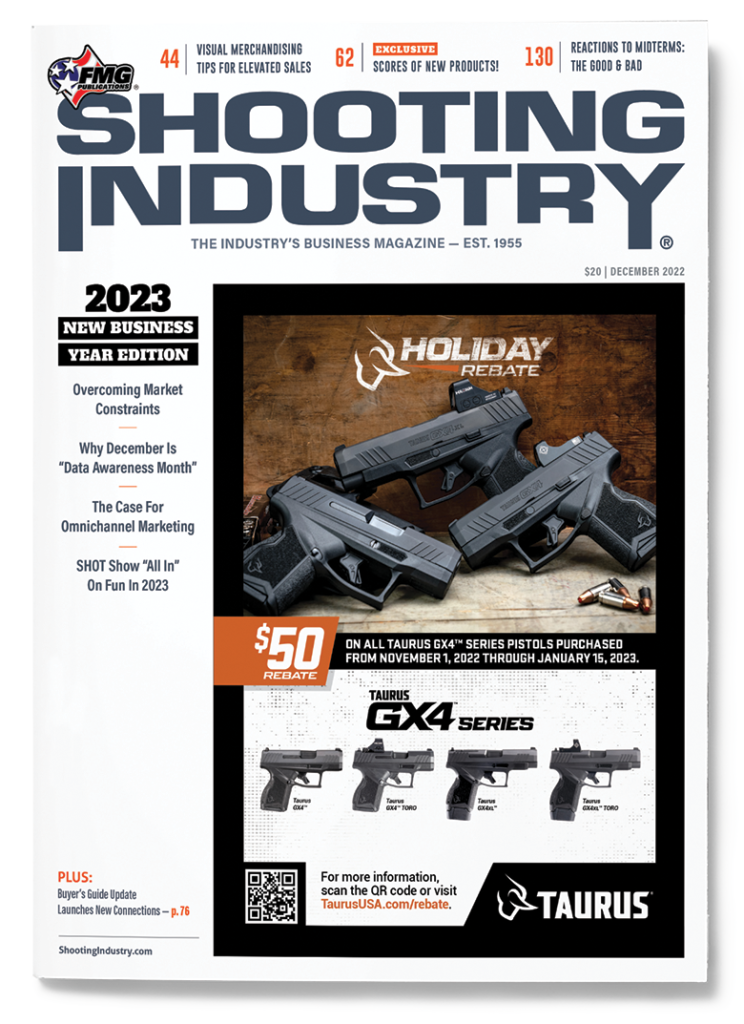5 Ways To Celebrate “National Firearm Industry Data
Management Month”
Welcome to “National Firearm Industry Data Management Month!” No, this isn’t a “real” event — but it should be.
December is a time of year when many retailers are largely distracted by higher daily sales, increased customer counts and managing the increased marketing efforts. Instead, they should be taking a large chunk of time out of the schedule to look at their sales data from the previous year.
Let’s explore the multiple reasons why you should be taking a deep dive into your sales data in December.
1. Tune-Up Your POS
First and foremost, it’s always good to put a consistent date on the calendar to be sure your point-of-sale (POS) system is collecting data properly. Things like system resetting, backing up data or establishing inventory value for end-of-year taxes are all imperative things to do before New Year’s Eve strikes.
This is also a good time to start planning end-of-year inventory audits and reconciliation. Why now? It’s quite likely (due to the brisk sales of the season) your inventory is at its lowest levels of the year, which makes it easier to do inventory counts — as well as to declare your inventory value for tax purposes.
Use the month of December to explore, manage and sort inventory and sales data, which will help you make tremendously improved buying decisions ahead of industry trade events.
2. Evaluate Employee Metrics
Next on the list is employee performance. Often the start of a new year is the time when many organizations conduct performance reviews and/or offer pay raises. Taking the time to look at sales performance metrics is a key element in determining the success or struggles of sales team members, inventory managers and other roles where POS data can be important.
By doing this in December, we can be prepared to have these performance reviews right after the holiday season ends — making performance reviews feel more relevant to employees.
Running reports such as Gross Sales Volume, Gross Profit Margin, Inventory Stocking Levels and Sell Through Rates (among others) are all data sets able to clearly describe the ability of employees to be productive and profitable.
3. Prep For Inventory-Buying Decisions
Here though, is where the rubber really meets the road and why December should be National Firearm Industry Data Management Month. January is by far the most condensed and fast-paced month of the year for making inventory-purchasing decisions.
In January, most retailers have multiple events they’ll be involved with — be it SHOT Show, distributor buying events, ATA Show, buy group markets, manufacturer-direct programs and the list goes on and on.
Use the month of December to explore, manage and sort your inventory and sales data, which will help you make tremendously improved buying decisions ahead of industry trade events.
Seeing how well products sold through, how profitable they were, what levels of inventory you still own and at what annual sales volumes they generated are all “must have” data sets to be able to smartly make buying decisions at vendor events.
4. Get More Bang For Your Buck At Vendor Events
Let’s dive into some of the basic information you should collect in the month of December to be ready for all the buying events in the month of January. First and foremost, it’s imperative to run sales reports on the major brands of products you sell. Seeing how well these products sold through, how profitable they were, what levels of inventory you still own and at what annual sales volumes they generated are all “must-have” data sets to be able to smartly make buying decisions at vendor events.
Once you’ve compiled this information at the brand level, it will not only help you target the best deals for your store, it can also make the time you need to spend in the vendor booth much shorter. We all know time is at a premium at vendor shows and this can help you cover the show more efficiently and facilitate more visits with vendors in the process.
With SHOT Show adding over 100,000 sq. ft. of show space in 2022, making efficient time in each booth has never been more important. If you’re able to understand the metrics that dictate the profitability of a product category — say, optics for example — you can make better choices around which brands you might want to abandon, invest more into or what new products and/or brands you might need to add to the assortment to optimize the product category.
5. Get In The Driver’s Seat
Coming to the table well prepared in a vendor booth will not only help you make smarter purchasing decisions, you can also set one brand against another.
For example, you might take your sales volume of brand “X” into the booth of a competing brand “Y” and say, “Mr. Manufacturer, in my market, I’m currently selling $200,000 a year of your competitor’s products — what program might you offer me to get a slice of that pie?”
Being able to confidently present the horsepower of your store to move products across the counter is a huge negotiating tool that puts you in the driver’s seat to negotiate far better deals than you could ever hope to without the data to prove your position.
It All Boils Down To This
Data management is cumbersome, time-consuming and tedious, but a necessary component for understanding any business. Trying to run reports last-minute before a vendor show isn’t going to yield the best results.
Carve out some significant time in December and invest it into understanding your inventory performance at as deep a level as you possibly can. Not only will you see better profits from it in 2023, but you’ll also find vendor events far more enjoyable to attend.






